Tortoises, turtles, and terrapins are often one of the top picks when people choose a reptile as a pet. Often unintentionally, these pets do not get the care they require. When getting their pet, people are informed incorrectly and/or insufficiently about the care they need. But before we dive into their care, it’s important to know if you want, or already have, either a turtle, tortoise, or terrapin as their needs are very different.
Tortoise, turtle, or terrapin
Tortoises, turtles, and terrapins are all genetically related, but they can’t interbreed. They all lay eggs, are cold-blooded (so they depend on external sources to regulate their body temperature), and have a shell. Still, there are some big differences between them. To provide them with the care they need, you need to know what their natural habitat and feeding pattern looks like.
Turtle
A turtle is adapted to living in the water and will only return to land to lay eggs. Their shells are streamlined and flat, and their feet are made for swimming with flipper-like limbs. Most turtles are omnivores, though there are some breeds that are either fully carnivores or vegetarian. Sea turtles can live up to 60-70 years.

Tortoise
The tortoise lives on dry land and is a herbivore. Their shell is usually round and domed. The feet are column-shaped for walking, and they have claws. Tortoises are not good swimmers and will drown in deep bodies of water. Occasionally, tortoises will enter an undeep body of water for drinking or bathing. Tortoises can live up to 60-80 years, with the Giant tortoise setting the bar at 150 years.

Terrapin
Terrapins are a type of turtle that is semi-aquatic and will spend their time partially on land, and partially in the water. Their shells are slightly streamlined and slightly domed. Their feet are webbed, but not flipper-like, like the turtle’s feet. Terrapins are a group of freshwater turtles that live in fresh and brackish waters. Freshwater turtles will live from 20-40 years. A very well known pet terrapin is the Red-eared terrapin, also known as red-eared slider. Because the terrapin is considered a turtle, from here on in this article we will focus on turtles and tortoises.

Enclosure
Tortoise
The first choice that you will have to make is if your pet tortoise will live inside or outside. The possibility of this will totally depend on your climate and the type of tortoise you get. If you pick a tortoise that originally lives in the same climate that you live in, they can be kept outdoors. Do not keep your tortoise outside if the climate of their natural habitat is not similar to your climate, it could cause illness, or they could die.
Choosing an appropriate enclosure is important, whether your tortoise lives in or outside. Generally speaking, an aquarium type of enclosure is not suitable for a tortoise. They lack proper ventilation and rarely have enough space. Glass enclosures are also stressful for them as they can see through them and will feel trapped. Better are the wooden pen enclosures that are available, or even free roaming with the right precautions taken.
Sizing of the enclosure will depend on the type of tortoise you get. Keep in mind that some tortoises will stay small, while others might grow into giants. So, when deciding on the enclosure, make sure to ask a professional how big your tortoise is expected to get and how much space they need. Proper enclosures for tortoises will be bigger than you might think. Keep in mind that if you plan on adding more tortoises, to add extra space.
Choose an appropriate bedding material for inside the enclosure. There is no one size fits all and picking one will depend on the type of tortoise, humidity, temperature, and setup. Just a few examples you could pick from are coconut coir, coconut chips, hay, straw, orchid bark, soil and many more. Whatever you pick, it is important to keep the following things in mind.
- Choose a material that is soft and doesn’t hurt your tortoise.
- Is edible and will not cause intestinal obstruction in case your tortoise will eat some of it by mistake.
- Is loose enough to dig and burrow in.
- Make sure to keep it clean and refresh when needed. Make sure it doesn’t grow moldy.
Besides bedding material, the enclosure will need enrichment material like logs, rocks, bathing dishes, moist hides, and dirt mounds. Make sure that there are no toxic plants your tortoise can reach. If the type of tortoise you have hibernates, make sure there are appropriate hibernation spots available.
Hibernation in tortoises and turtles is actually called brumation. The difference with hibernation is that they don’t fully sleep throughout the brumation cycle. Instead, they may wake up several times to drink and/or change position. Tortoises need very specific conditions to facilitate brumating, and if you don’t provide them with this special location your tortoise could die. Also, make sure you provide proper lighting in their enclosure that provides UVA and UVB.
Turtles
Before setting up your turtle’s tank, it is important to research the needs of the specific turtle you have or plan on getting. Not all turtles need an aquatic setup. For instance, the box turtle will require a terrarium.
Water turtle tanks
Turtles need about 10 to 15 gallons of tank space for every inch of shell. For every additional turtle, add half the original tank capacity to the first turtle’s full capacity. Depending on the type you get, turtles can grow large, so keep in mind you might need to expand several times in their lifetime. The glass of the tank needs to be at least 10 mm thick. The depth of the tank needs to be more than the width to make sure the turtle can flip if it ends up on its back. Turtles can drown if they get stuck. Make sure to not place the tank in direct sunlight to prevent the tank from heating up too much. The tank will need a powerful and appropriate filter. Keep in mind, fish tank filters might not be strong enough as turtles are more messy than fish, so use double capacity. Depending on the type of turtle, get a water heater if needed.
Freshwater turtles need basking spots. You can provide a special lamp above these spots for heating and UV. Basking is needed to give the turtle the chance to fully dry up which will prevent infections, keep them warm, and get the needed UVB rays. You can find more information about UVA and UVB further in the article
Bedding in the tank will make it harder to clean, but will make the surroundings for your turtle more natural. Examples you can use are pebbles, fluorite gravel and sand. Make sure to create some hiding spots and caves for your turtle to hide in so they can feel comfortable. Live plants, logs, and smooth rocks will provide enrichment for your turtle, but make sure they have enough room to swim and bask. When choosing accessories keep the following in mind.
- Make sure plants are non-toxic.
- Make sure there are no sharp edges.
- Decorations need to be bigger than 1 inch to stop them from being eaten.
- Do not place decorations underwater as turtles can drown. Caves and hiding spots should be on the dry part of the enclosure.
Just like with tortoises, some breeds of turtles brumate. If you have a turtle that brumates, make sure to facilitate their needs. If you wish to keep your water turtle outside in a pond, it is best to consult with experts to make sure the pond is suitable.
Conclusion
Picking the right enclosure for your pet turtle or tortoise is an important step in providing them with the care they require. There is more important information regarding their care any (potential) turtle or tortoise owner should be aware about, like the diet they require. To read more about this, have a look at our blog “Beginner’s guide to Turtle and Tortoise care – Lighting, Feeding and Handling”. Did you know we also pet turtles and tortoises? Our reptile sitters are knowledgeable about their care and will love your turtle or tortoise like it’s their own. Feel free to contact us for more information about our pet sitting service in Dubai. Our team will be happy to help.

